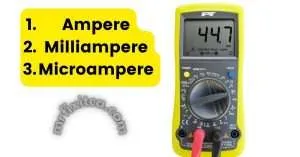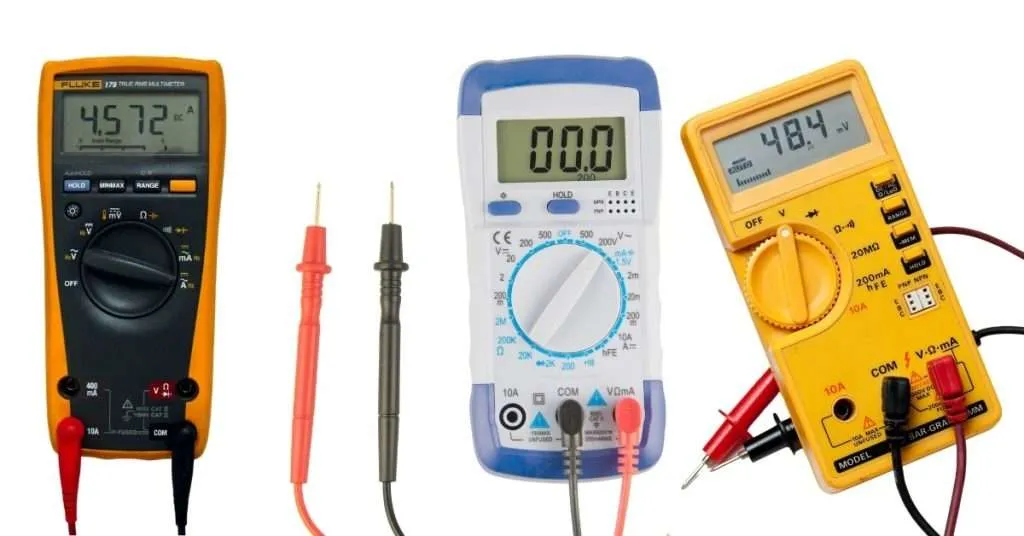It is unclear for students and electronics beginners to understand What does 50 milliamps look like on a multimeter? Milliamp or other subunits on multimeter.
If you are stuck on how to read milliamps on a multimeter, milliamp to amp conversion, or what 50 milliamps look like on a multimeter. In this post, we’ll solve all your concerns about the current measurement with a multimeter.
Table of Contents
ToggleWhat does 50 milliamps look like on a multimeter?
Most of the multimeter displays result in amps. When such a multimeter reads current less than an ampere, it automatically converts milliamperes into amperes. As a result, you get the value in decimal. Decimal reading on a multimeter means that the measured current is a fraction of an ampere.
A multimeter will display 50 milliamps reading as .05 ampere. You can verify this value by multiplying the ampere value by 1000, as one ampere equals a thousand milliamps.
However, other multimeters also have a milliamp range setting to measure current less than an ampere. Such a multimeter will show a 50 milliamp reading as 50 mA, where mA represents milliampere.
What are ampere, milliampere, and microampere?
-
Ampere
Ampere or amp is the measuring unit of electric current, denoted by A. Ampere is equal to the number of electrons passing through a wire or conductor per second.
So ampere is equal to coulomb per second or A=C/s.
1 amp = 1000 milliamps
1 amp =
-
Milliampere
Milliampere, also termed milliamp, is the thousandth part (1-3 or .001) of an ampere. It’s the first smaller unit of an ampere denoted as mA. We use milliamp to measure current less than an ampere.
-
Microampere
Microampere or microamp is the millionth part (1-6 or .000001) of an ampere. SI unit of microampere µA.
How to convert Milliamp to Amps
Milliampere is the thousandth part (1/1000) of an ampere. To convert a milliamp to an amp, divide the milliamp reading by 1000. For amps to milliamps conversion, multiply the amp reading by 1000.
Remember: One milliamp is equal to .001 amp, and one amp is equal to 1000 milliamps.
Example
- Convert 50 milliamps to amps:
1 milliamp = .001 or 1-3 amps
50 milliamps = 50/1000 =.05 amp
That’s how 50 milliamps look like .05 amp on multimeter.
- Covert 5 amps to milliamps
1 amp = 1000 milliamp
5 amp = 5×1000 = 5000 milliamps
5 amps are equal to 5000 milliamps
How to convert Microamp to Amp
As you know, microampere is the millionth part of an ampere. There are 1000000 microamps in 1 ampere. To convert amps to microamps, multiply 1000000 by the amp value. For microamp to amp conversion, divide the microamp value by 1000000.
Remember:
1 microamp = 1/1000000 = .000001 amp or 1-6 amp
Example
- Convert 50 microamps to amps:
1 Microamp =1/1000000 = .000001 amp
50 microamp = 50/1000000 = 0.00005 amp
- Convert 50 amps to microamps:
As 1 amp = 1000000 microamp
50 amp = 50×1000000 = 50000000 = 5×107 microamp
How to convert milliamps to microamps?
As one microamp is equal to .000001 or 1-6 amps and one milliamp is 1-3 or .001 amps, 1 microampere is the thousandth part of a milliampere and is equal to .001 milliamp.
For milliamp to microamp conversion, multiply the milliamp value by 1000. To convert microamps to milliamps, divide the microamp reading by one thousand.
Remember:
1 microamp=.001 milliamp and 1 milliamp = 1000 microamp
Example
- Convert 50 microamps to milliamp
One microamp=.001 milliamp
50 microamp=50x.001 =.05 milliamp
- Convert 50 milliamps to microamp
1 milliamp = 1000 microamp
50 milliamps = 50×1000 = 50000 microamp or 5.0×104 microamp
How to measure current with a multimeter?
To measure current with a multimeter:
- Insert probes in the multimeter so the black probe goes to the COM port. To measure the current in the milliamps or microamps range, insert the red probe into the port labeled with VΩmA.
- To test high amps with the multimeter, insert the red probe in another port labeled with the maximum ampere range, like10A max or 20A max.
- Also, you should know if you are checking an AC or DC circuit. So you can adjust the setting accordingly.
- After setting in AC or DC mode, adjust the range on the multimeter to ampere or milliampere, and it must be above the circuit you are testing.
- Suppose you have adjusted the range in milliampere or microampere and test for a device carrying current in amperes. It will probably burn the multimeter fuse.
- Connect black and red probes to the terminals of the device or circuit you are examining.
- If you have adjusted the incorrect range multimeter will show errors such as one or OL.
- After adjusting the correct range, the multimeter will show you the current passing through the circuit.
This is how to test amps or milliamps with a multimeter.
FAQs
What is the symbol for milliamps on a multimeter?
On a multimeter, the symbol of milliamp is mA, Microamp is µA, and amp is A. You will see these symbols on both DC and AC range settings.
How to test amps with a multimeter
First, to test amps with a multimeter, adjust the amp range in AC or DC mode. The multimeter ampere limit must be higher than the circuit’s current carrying capacity.
Insert the black probe in the COM port and the red probe into the port labeled with the max ampere range. Connect the black probe to the negative terminal and the red probe to the positive terminal of the circuit or battery.
What setting on a multimeter do you use to test milliamps?
To test the milliamp range current, select DC or AC mode, and turn the multimeter dial to the mA or m sign in the ampere setting labeled with A.
Also, you must select the milliamp range, so the device you are testing is under the multimeter limit. For example, to test a device of 100 milliamps, the multimeter dial should be set at 200mA or any range above 100 milliamps.
Conclusion
To understand what 50 milliamps look like on a millimeter, you must have an idea to convert milliamps to amps and other measuring units. Hopefully, you can now measure current and understand the readings on the multimeter.
Related Guides:






